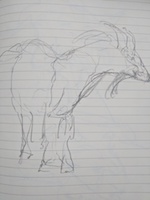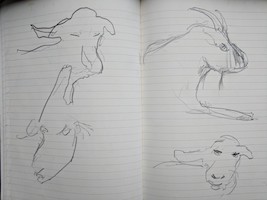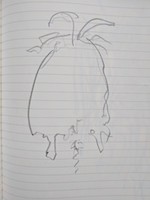Don’t Read THAT, Read THIS
Join us on Wednesday, September 5, at Third Place Books Seward Park for the next Reading Through It Book Club. We’ll be discussing Kurt Andersen’s Fantasyland: How America Went Haywire. You can buy the book for twenty percent off right now at Third Place Books in Seward Park.
To explain the global energy crisis, William T. Vollmann taught himself the concepts needed to grasp energy systems, including arithmetic, ecology, engineering, chemistry, politics, and waste disposal.
No Immediate Danger, the first of Vollmann’s two-volume Carbon Ideologies, begins with a 200-page primer on power and climate that conveys a sense of intuition on large-scale numbers. For example, he lists how much power it takes to operate a light bulb, refrigerator, or television in terms of the energy required to run a plug-in vibrator for one minute. (If you hear a buzzing sound coming from one of your household appliances, now you know.) This is essentially an application of the Feynman Technique for learning scientific concepts: To learn something, explain it in your own words, using analogies that resonate with your own experiences.
Carbon Ideologies is addressed to our heavily burdened descendants:
We all lived for money, and that is what we died for.
Now that we are all gone, someone from the future is turning this book’s brittle yellow pages. Unimpressed with what I have written so far, he wishes to know why I didn’t do more, because when I was alive there were elephants and honeybees; in the Persian Gulf people survived the summers without protective suits; the Arctic permafrost had only begun to sizzle our methane; San Francisco towered above water, and there were still even Marshall Islands; Japan was barely radioactive, Africa not entirely desertified.
I couldn’t finish the book, nor did I pick up the second volume, No Good Alternatives.
Six months from now, we may be burning our libraries for heat during the first winter following the crippling cyberhack of our national power grid; or trying to survive the Siege of Seattle after the splintering of the Western states by Russian-backed militias trying to fulfill their murderous millenarian survivalist fantasies. By this time next year, the lucky ones may be living out of suitcases; or trapped in camps for displaced persons; or fleeing the heat as climate refugees.
There’s a time for books that go “thump!” and times — like now — for short books that get their point across efficiently, elliptically, poetically.
Instead of Carbon Ideologies, a two-volume exploration of every conceivable aspect of energy policy, try The Emissary, by Yoko Tawada (translated from the Japanese by Margaret Mitsutani), a slim novel about humans that adapt to climate change and radiation poisoning through metamorphosis into new life forms.
In the novel, environmental disasters have turned children into completely dependent blobs of flesh who need to be cared for by the only generation remaining with motive power, the great-grandparents. For an apocalypse, it’s kinda cute, and refreshingly optimistic about the ability of life to evolve.
Japan, as with every other country, has gone its own way to deal with its overwhelming problems on its own. There’s no more contact with the outside world, no more global trade, and interior movement within the country is strictly controlled. Even speaking the name of a foreign world has been proscribed:
There was a strange new law against saying the names of foreign cities out loud, and although no one had been prosecuted for breaking it yet, all the same people were being very careful. Nothing is more frightening than a law that has never been enforced. When the authorities want to throw someone in jail, all they have to do is suddenly arrest him for breaking a law that no one has bothered to obey yet.
Yet The Emissary isn't all Orwellian darkness. To the contrary, it’s a peppy novel in which the undying elderly continue into extreme old age, supporting not only themselves but also successive generations of increasingly helpless descendants.
The great-grandparent Yoshiro takes care of the uncomplaining Mumei (“no-name”), a bird-like humanoid who prefers worms to milk, and whose soft teeth cannot chew on bread or the skin of an orange. Mumei is obsessed with animals, even as wild animals have largely disappeared from daily experience.
The Japanese calendar has been rewritten with new holidays, with “Children’s Day” renamed to “Apologies to the Children Day,” and “Labor Day” changed to “Being Alive Is Enough Day.” (Those are good ideas for holidays, why wait?)
Tawada depicts daily life following collapse as imbued with radical simplicity. People live in prefab houses that can be easily cleaned with a broom and mop-up rags; clothes are hung out to dry in the sun (“Listening to clothes slosh around in a washing machine makes your thoughts dry up.”); and save for solar-powered refrigerators, electrical appliances have disappeared. (Again, why wait?)
Mitsutani’s translation contains some clever wordplay involving kanji characters, which led me to look for the Japanese-language original, titled Kentoshi. Yet despite all the great reviews that the Akutagawa Prize–winning Yoko Tawada has received in the English-language and German literary press (Tawada lives in Berlin), Seattle’s Japanese-language bookstore Kinokuniya didn’t have any of her works in stock, and I would have had to special-order a copy. Meanwhile, the collected works of Haruki Murakami get their own shelves in both English and Japanese. That doesn’t make sense to me, but maybe Tawada will become a household name in Japan once environmental degradation really kicks in.
Read THIS: The Animal Gazer
Elias Canetti’s Auto-da-Fé (translated from the German under the personal supervision of the author by C.V. Wedgwood) is a caustically funny 1935 novel about reclusive 40-year-old virgin Peter Kien, a “Professor” with no students who resides in his 25,000-volume library writing brilliant academic papers sent to conferences he won’t attend. Professor Kien lets nothing distract him from the beloved books feeding his prodigious and capacious memory.
He knew more than dozen oriental languages. A few of the western ones did not even need to be learnt. No branch of human literature was unfamiliar to him. He thought in quotations and wrote in carefully considered sentences. Countless texts owed their restoration to him.
Kien had hired a housekeeper in a blue starched skirt, Therese Krumbholz, to dust his bookshelves. For eight years, she fulfilled her daily task, even while searching for what she believed to be his secret vice, something like a body hidden under the floorboards. Then, inspired by the wisdom of Confucius, Kien asks for Therese’s hand in marriage. But Therese is hardly the person he had imagined her to be. They marry, they clash, they go to war with one another.
Canetti earned a doctorate in chemistry, which is perhaps why this setup has the feel of a science experiment: What if you mixed a pure substance, let’s call it Kienium, with a beaker of Krumbholzine solvent? As with all entertaining chemistry experiments, the result is a sizzling, smoking, acrid build-up to an explosion.
After reading Auto-da-Fé last year, I began wondering whether science-trained writers write fiction differently from everyone else. Primo Levi’s chemistry training helped him survive Auschwitz, and chemistry provided an organizing principle for his autobiographical work The Periodic Table. Kurt Vonnegut's father insisted that he study chemistry in college. (I’m looking for more examples, so send your substantive tips to ivan@ivantohelpyou.com.)
To continue this research project, I acquired a copy of Canetti’s 834-page, three-part memoirs: The Tongue Set Free, The Torch in My Ear, and The Play of the Eyes.
I haven’t yet gotten very far with Canetti. That’s because the obvious prerequisite to writing about chemistry-influenced writers is to learn chemistry. I’ve been watching online lectures, reading used textbooks, and puzzling through problems in stoichiometry and thermodynamics. I even considered buying an old-fashioned chemistry set, but then reconsidered that plan, as I am quite fond of my home and the neighbors.
For the chemistry-themed essay I have in mind, I would complete selected works of Canetti, Levi, Vollmann, Vonnegut, and others; complete a survey of basic science; and research the supplemental literature to situate the discussion within the existing scholarly discourse. I can hear it in my mind, a beautiful essay just waiting to be written. But not this year.
See you later, Schrödinger! Au revoir, Lavoisier! Dosvedanya, Mendeleev!
Instead of reading the complete works of Elias Canetti, including Crowds and Power, with its piercing insights on rising fascism and popular movements in the 1930s, how about a slim World War I novel about an Italian sculptor who channels his energies into observing zoo animals?
I recently saw an NHK documentary about an art school in Kyoto that pairs each of its students with a live chicken. The students spend an entire semester watching, studying, and sketching their chickens, observing and internalizing their movements to capture their essences on paper. This approach to animal portraiture requires an accumulated knowledge of the animal’s movements, behaviors, and personalities.
Last month, I tried drawing the goats at the Old Faithful Animal Farm at Old Faithful Geyser of California. The problem is that the animals rarely pose like diorama animals. Most of the time they’re sleeping or lounging around, and they generally refuse to take direction. If a curious goat comes over and looks at you, by the time you start sketching, the goat’s looking this way and that way, and how are you supposed to draw a moving animal head? I can only imagine what it’s like to draw a live chicken!



Here’s when the goat stood still the longest:

The Animal Gazer, by Edgardo Franzosini (translated from the Italian by Michael F. Moore), depicts the wartime experience of the Italian sculptor Rembrandt Bugatti, whose artistic practice centered on daily visits to zoos in Paris and Antwerp.
There’s your crowds and power, there’s your ignorant bloodlust, there’s your insight into the nature of war. In Paris, Bugatti goes to the zoo, goes to the circus, thinks about animals, talks about animals with this brother, debates animal intelligence with local intellectuals, and hobnobs with the nobility. He meets Auguste Rodin, with whom he has a mutual admiration even though their approaches are completely different:When the Jardin des Plantes opened the public, at around ten o’clock in the morning, and the animal moved from the back of its cage (sometimes it was forced to the front by pushes and shoves) before the stares of the crowd, on the makeshift stage where it performed every day, Rembrandt, too, stopped by the cage and sat on a bench. If there was a bench. Otherwise he remained standing, but without taking his eyes off the animal. As if he wanted to understand the nature of its thoughts, or rather, as if he wanted to get under its skin.
On some of the animals the fur was shiny and the nostrils wet. Animals that had been robbed of the joy of blood, the lust for tearing their prey limb from limb. Animal life, thought Rembrandt with a obscure sadness, perhaps, and fortunately, does not demand a huge amount of learning, does not demand long and complex efforts.
One man spent hours and hours at the Louvre, as if he were listening to a long concert of beautiful music, where he would feel exhilarated, ecstatic, and find stimulation for his work. The other confessed that his only consolation was spending the whole day at the zoo.
One man challenged everybody: “I dare you to tell me that I’ve made an error, a single mistake in my anatomy!” The other admitted, without pride, without arrogance, that he completely ignored the anatomy of his models and trusted only in the precision of his eyes.
For one man, art demanded patience, perseverance, and he commented, “When you work, progress is slow, uncertain.” The other sculpted quickly, decisively, and without hesitation.
Bugatti learned from the animals how to create art as would a non-human animal, not by assuming a pose of anthropocentric superiority by relying on dissections, but rather by slow and careful observation.
On the walls of the Egyptian Temple at the Antwerp Zoo, Bugatti sees an animal-themed mural depicting “a world in which there is no defined hierarchy in creation, no hierarchy in which man occupies a position superior to other creatures.”
Viewing that mural, Bugatti recalls his “wish to consecrate all his time, all his energy, and all his qualities, conspicuous or insignificant though they might be, to the realization of works that no animal sculptor, ancient or modern, had ever succeeded in conceiving.”
What a pleasant way to spend a war.
Be it resolved
Kurt Andersen’s Fantasyland charts the trajectory of this insane country as a historical procession of hucksters preying on the gullible, but after a few chapters I just couldn’t do it anymore, and so I took Fantasyland to Mercer Street Books and traded it in for a Spanish vocabulary book.
One of their wonderfully perceptive booksellers: “It sounds like you’ve given up trying to figure out what’s wrong with this country, and now you just want to leave.”
I’ll concede the first point. Andersen convincingly diagnoses the central malady afflicting the republic, but I’m not sure what to do about it. The people most afflicted by delusion are the least receptive to being told they’re deluded, especially by globalist eggheads like me. (Maybe you’ll figure out a workable approach at next month’s Reading Through It Book Club, on Wednesday, September 5, at Third Place Books Seward Park.)
As for the second point, I’m not going anywhere. I like it here. I still feel welcome here. I’m learning Spanish for several reasons — the primary one being the desire to read contemporary Spanish-language literature beyond translations. Maybe it’s an urge to look in the mirror, to get a view of our Fantasyland from an outside perspective. Just as you can see Manhattan best from New Jersey, the clearest portrayals of the United States will be found from those authors who intuitively understand the US from Mexican, Caribbean, Central American, or South American vantage points.
You can learn much from what you let go, and what you get in return. With that in mind, allow me to offer some reading resolutions that you may find well suited for our smoke-filled, choked-up, coughing-spasmed world:
- Trade in the trophy shelf (oh hello Tolstoy) for new enthusiasms.
- Follow flashes of brilliance rather than extended expositions.
- Leave some difficult challenges unsolved.
- Seek out shorter books with style.
- No more nemesis projects.
- Stop digging deeper.
- Wander wider.
Our beautiful lives are fleeting and transient — so let’s read shorter books, shall we?
Ivan writes shelf talkers for Mercer Street Books. You can also find him at www.ivantohelpyou.com.
Follow Ivan Schneider on Twitter: @ivantohelpyou
Other recent reviews
Talk about the weather
-
Interpretative Guide to Western-Northwest Weather Forecasts
March 27, 2018
72 pages
Provided by publisherBuy on IndieBound
The man show
-
The Sexiest Man Alive
October 01, 2018
72 pages
Provided by publisherBuy online
Accidentally honest
-
The Shame of Losing
October 01, 2018
264 pages
Provided by authorBuy on IndieBound